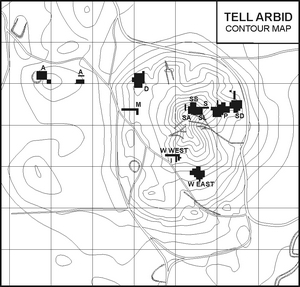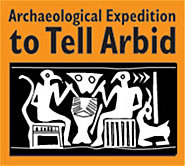RESEARCH

Click a sector from the menu to get more info on details of excavations in the different areas of the tell.
Excavation results:
Information on the results of recent seasons can be found in a PCMA Newsletter:
- Season 2006 (sectors SD and W)
- Season 2007 (sectors D and W)
- Season 2008 (sectors SS and W)
- Season 2009 (sector W)
- Season 2010 (sector W)
Since 1996, excavations at Tell Arbid have been carried out every year. Their results lead to a doubtless conclusion that the most prosperous period for the ancient Arbid was the IIIrd millennium B.C. The ruins of an extensive city dated to the Ninevite 5 period cover almost the entire site. The city comprised of domestic quarters, household activity areas and areas presumed to be of official and sacred character. Traces of Ninevite 5 settlement have been found in almost every trench.
Also in the ED III period, most of the site was densely settled. A monumental structure with buttresses, labelled “the Public Building”, dates to that period; located at the very top of the main tell, it must have had an official, presumably administrative, function. After the ED III period, the settled area shrank considerably. Remains of the Akkadian period are much scantier and preserved only in a few places on the site. They include, however, buildings of high quality and an abundance of complete vessels.
The time of well-being was followed by a crisis, or transformation, at the end of the IIIrd millennium BC, during the so-called “Post-Akkadian" period. Ceramic material indicates that Tell Arbid was occupied at this time, but not much can be said of the character of this occupation. The Post-Akkadian remains were sealed with Middle Bronze Age strata. After the transition, at the beginning of the IInd millennium, the pattern of settlement and its intensity changed once more. The MB remains are less extensive than in the IIIrd millennium and they do not cover the entire site. They are concentrated in several areas of the main tell and present a pattern of regular settlement with domestic architecture, areas of household activity and numerous intramural graves. After the MBA, traces of occupation of the Late Bronze Age (Mitannian period) have been attested. Some houses and two very richly equipped tombs from this period were uncovered, indicating that a well prospering elite inhabited Tell Arbid at that period. After the Mitannian Period there was a break in occupation until the Iron Age with some Neo-Babylonian settlement. Of this period just a few structures of domestic character were found. They were accompanied by some small finds, such as cylinder seals and sealings. The latest traces of settlement on Tell Arbid come from the Hellenistic Period. Although it was of a farm-type, it represented a period of stabilization and well-being, as can be judged from the solid architectural remains, rich graves and precious small finds. Until now, Hellenistic settlement has been attested only in two places on the site.
The results are presented by sector, in stratigraphical order, from the latest to the earliest layers.
Chronology:
The date of the founding of the site is not certain. There are some meagre traces of Halaf occupation, mostly beyond the main tell, but the earliest traces of well-established settlement come from the Early Bronze Age. The site was occupied throughout the Bronze Age. It provides a ceramic sequence for almost all of the EBA, since the Ninevite 5 period (that is Early Jezirah I-II), through the Early Dynastic III (EJ III) and Akkadian (EJ IV) periods. Although occupation from the Post-Akkadian period (EJ V) has been attested, we still don’t know much about the character of the transition into the Middle Bronze Age. A ceramic sequence is available also for the IInd millennium B.C. The MBA is represented mostly by Khabur Ware period remains (MB II) but some relicts of the MB I also have been discovered. The transition into the Late Bronze Age is not very clear, however traces of Mitannian period settlement are obvious. After the LBA, there was a break in occupation until Neo-Babylonian times in the Iron Age. The latest settlement is dated to the Hellenistic Period.
Periods:
| Period: | Jezirah Periodization: | Dates BC: | Sectors: |
|---|---|---|---|
| Ninevite 5 | Early Jezirah I–II | 2900-2600 BC | D, M, S, SD, W |
| Early Dynastic III | Early Jezirah III | 2600-2350 BC | D, S, SD, W |
| Akkadian | Early Jezirah IV | 2350~2100 BC | S, SD, W |
| Post-Akkadian | Early Jezirah V | ~2100~2000 BC | P(SR), S, SD, W |
| Middle Bronze I | Old Jezirah I-II | ~2000~1800 BC | S, SD |
| Khabur Ware | Old Jezirah III | ~1800~1500 BC | D, M, P(SR), S, SD, W |
| Mitannian | 1500~1300 BC | A, S | |
| Neo-Babylonian | ~VI BC | A | |
| Hellenistic | up to II BC | A, D |
 top
top


